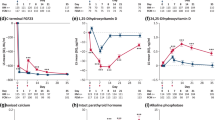Abstract
Hypophosphatemia is a rare side effect of intravenous iron replacement. Urinary phosphate wasting due to increased FGF23 is the most likely mechanism. Here, we present a case of intractable hypophosphatemia in a 32-year-old female patient with history of ulcerative colitis (UC), who was primarily hospitalized due to UC flare-up. Her urinary fractional excretion of phosphate was inappropriately elevated at 70%. A careful history revealed that she had been treated with ferric carboxymaltose 2 weeks prior to hospitalization, leading to a diagnosis of iron-induced hypophosphatemia. She was treated with 5 weeks of intravenous sodium phosphate since she did not tolerate oral supplementation. In conclusion, clinicians should be aware of iron-induced hypophosphatemia and be cautious when prescribing intravenous iron.

Similar content being viewed by others
References
Edmonston D, Wolf M. FGF23 at the crossroads of phosphate, iron economy and erythropoiesis. Nat Rev Nephrol. 2019;16(1):7–19.
Wolf M, Chertow GM, Macdougall IC, Kaper R, Krop J, Strauss W. Randomized trial of intravenous iron-induced hypophosphatemia. JCI Insight. 2018;3(23):e124486.
Coppolino G, Nicotera R, Cernaro V, Calimeri S, Leonardi G, Cosentino S, et al. Iron infusion and induced hypophosphatemia: the role of fibroblast growth factor-23. TherApher Dial. 2019;24(3):258–64.
Wolf M, Koch TA, Bregman DB. Effects of iron deficiency anemia and its treatment on fibroblast growth factor 23 and phosphate homeostasis in women. J Bone Miner Res. 2013;28(8):1793–803.
Bager P, Hvas CL, Dahlerup JF. Drug-specific hypophosphatemia and hypersensitivity reactions following different intravenous iron infusions. Br J ClinPharmacol. 2017;83(5):1118–25.
Schaefer B, Wurtinger P, Finkenstedt A, Braithwaite V, Viveiros A, Effenberger M, et al. Choice of high-dose intravenous iron preparation determines hypophosphatemia risk. PLoS ONE. 2016;11(12):e0167146.
Zoller H, Schaefer B, Glodny B. Iron-induced hypophosphatemia: an emerging complication. CurrOpinNephrolHypertens. 2017;26(4):266–75.
Acknowledgements
All authors had access to the data and role in writing the manuscript. Informed consent was obtained from all individual participants included in the study.
Author information
Authors and Affiliations
Corresponding author
Ethics declarations
Conflict of interest
None of the authors had conflict of interests.
Additional information
Publisher's Note
Springer Nature remains neutral with regard to jurisdictional claims in published maps and institutional affiliations.
About this article
Cite this article
Efe, O., García, J.D.C., Mount, D.B. et al. Refractory hypophosphatemia following ferric carboxymaltose administration. CEN Case Rep 10, 473–475 (2021). https://doi.org/10.1007/s13730-021-00590-1
Received:
Accepted:
Published:
Issue Date:
DOI: https://doi.org/10.1007/s13730-021-00590-1




